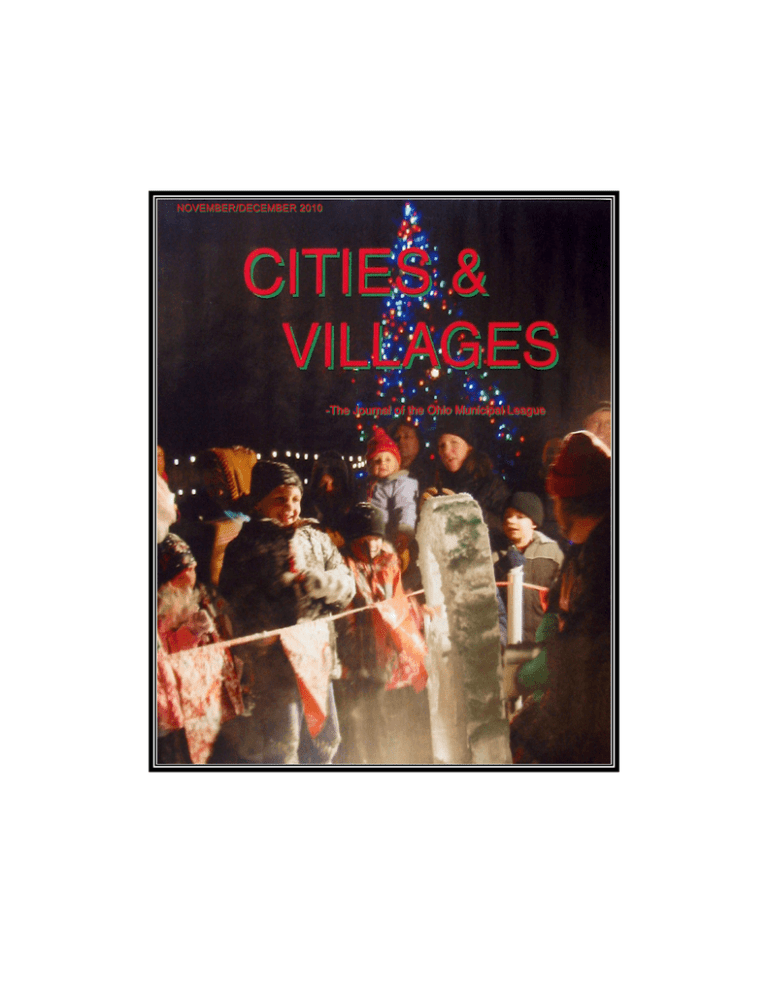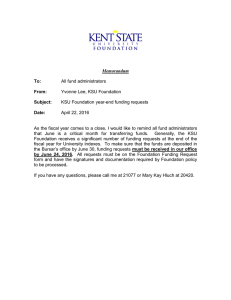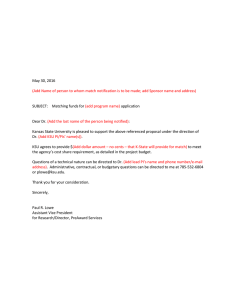Document 13800229
advertisement

Intergovernmental Collaboration: A Useful Tool in Tough Fiscal Times Josh Filla John Hoornbeek Center for Public Administration and Public Policy Kent State University The Great Recession has hit government budgets at all levels. Ohio’s local governments are no exception. According to the Columbus Dispatch, “A record 20 local governments, including one county, are on Ohio’s fiscal emergency list.” That article was published in March of 2010. By October of 2010, Randy Cole of the Ohio State Auditor’s Office reported to local government officials at Kent State University’s (KSU) annual training conference for professional municipal clerks that the number of local governments on the fiscal emergency list had increased to 26, yet another state record. “And, unfortunately, this may be just the tip of the iceberg”, said Mr. Cole at the time. Exacerbating the problem are the State of Ohio’s fiscal issues. Ohio currently faces an estimated six to eight billion dollar budget deficit for the upcoming two year budget period. With a significant chunk of the state budget dedicated to funding local governments, local administrators can expect less help from the state in the coming years. The Cleveland Plain Dealer recently highlighted the Medina Police Department’s efforts to deal with a shrinking revenue base. The department slashed spending by reducing salary increases, cutting personnel overtime, reducing technology investments, and closing the city jail and moving inmates to a county facility. Cuts such as these are now a reality for many local governments in the state. Medina Mayor Dennis Hanwell, who help orchestrate the Medina Police Department cuts, is not happy with the effects of the Great Recession on local revenues, but he does see a need to take action. “We are not the only ones having to make cuts”, he says. “Local governments throughout the state are facing fiscal challenges that will require new and creative ways of getting things done”. In spite of these fiscal challenges, local governments still have to provide needed services and meet the demands of their citizens. However, simply slashing programs and reducing services to citizens is not the only option in tough fiscal times. Governments have the ability to work together to save money, provide better services, and grow their communities and the state as a whole. While local government collaboration is not always easy, it does hold the potential to help in all of these ways. Increased Cost Efficiency Recent studies conducted by KSU’s Center for Public Administration and Public Policy (the KSU Center) and Miami University indicate that cost savings is a major motivation for governments to collaborate with one another. These studies contribute to a growing body of evidence that collaborations among local governments can in fact yield cost savings for the governments involved. The City of Tallmadge, Ohio saved well over a quarter million dollars annually by contracting with the City of Stow to provide Tallmadge’s dispatch services, according to its Director of Administration, Dr. Tom Pascarella. “The city is saving over $360,000 in operating costs annually, and that figure does not include debt payments on capital investments that would be needed if we were to be operating our own dispatch center.” Tallmadge would have had to invest over $1.3 million in their dispatch center if they had chosen to keep it open and operational. Recent surveys conducted by the KSU Center highlight the potential for intergovernmental collaborations to yield cost savings to partnering communities. One survey queried collaborating local governments across the state, and its results were published in the fall 2009 report, Local Government Collaboration in Ohio: Are We Walking the Walk or Just Talking the Talk? This report indicated that more than half (56%) of the responding governments engaged in collaborations were either currently receiving cost savings or expected to in the future. Another set of KSU surveys focused on participants in the Fund for our Economic Future’s (FFEF) EfficientGovNow (EGN) grant program, a northeast Ohio program to support local government collaborations and citizen engagement. One of these surveys found that half of the EGN applicants who indicated they were moving forward with their projects were already experiencing cost savings, and all of these respondents expected cost savings in the future. Improving Service Delivery Intergovernmental collaborations can also help local governments provide better services for their citizens. One area where greater collaboration among local jurisdictions can improve service is public health. Local public health departments immunize children against disease, inspect food service establishments to ensure sanitary conditions, and educate the public on preventing disease. Their effectiveness depends on having good information about the citizens and the jurisdictions they serve. Unfortunately, however, the ability of public health departments to collect, analyze, and share data on diseases and their potential transmission can be compromised by fragmented public health systems. In Summit County, three public health departments -- the Summit County Health District (SCHD), Barberton Health District (BHD), and the Akron Health Department (APHD) -- have historically had problems sharing data, in spite of the fact that their jurisdictions overlap. Technical issues, such as incompatible software, and political differences contributed to the inability of the three agencies to share data effectively. Kelly Engelhart, a former Director of Nursing with the Portage County Department of Health and now Senior Research Associate with the KSU Center, says this is a common concern. “Being effective at protecting public health is about being able to collect relevant data, having the capacity to analyze the information, and then being able to act effectively based on what was learned”, she said. “Often times, fragmented departments have difficulty doing this.” Recognizing this concern, the three Summit County health agencies are now collaborating more closely by consolidating their operations into a single department. A recent analysis by the Center for Community Solutions showed that a consolidated department could not only save money, but also improve the quality of public health services in Summit County. The consolidation plan received funding from area hospitals and a local foundation and is now being implemented by the departments involved. Achieving service improvements through local government collaborations is not limited to the field of public health. The KSU Center’s survey of EGN applicants showed 30% of those who have begun to move forward with their projects have already perceived improved service delivery to their communities, and all respondents anticipate service improvements as their collaborations move forward. Growing Local Economies Intergovernmental collaboration also holds the potential to yield economic benefits for participating communities and the state as a whole. In the modern world, economic competition is global in scope. This makes it hard for a single city in Ohio to be competitive when working alone. Twenty-first-century businesses choose among globally situated regions when deciding where to locate, and they are often less focused on individual communities. As a result, collaborative economic development projects are becoming more common. The Youngstown, Ohio region has been hit hard by the decline of the steel industry and, as a result, the area is populated by multiple abandoned industrial sites. The redevelopment of these “brown-fields” by new industries has long been a priority for the area. However, because these brown-fields and the industrial facilities that occupy them stretch across multiple jurisdictions, the Mahoning River Corridor Initiative (MRCI) – an association made up of governments, non profit groups, and Youngstown State University -- developed a collaborative approach to address the problem. The MRCI developed a joint interactive marketing website for the region that would provide a one-stop clearinghouse of information aimed at recruiting potential industries to make use of all of the properties, regardless of the local jurisdiction in which they resided. The group submitted a plan for their cooperative economic development website to the EGN program and it was one of three collaborative projects to win an EGN grant in 2009. The result was the “Rollin on the River” project, which was successful in releasing its website in September of 2010. “The result has been a series of inquiries about the properties and other available facilities”, said Dan Mamula, the project’s leader and former Mayor of the City of Struthers – one of the participating communities. “We hope to turn these inquiries into new users of these properties in the coming months”, he added. The MRCI partners have also moved forward with the creation of a joint economic development agreement with neighboring municipalities and are pursuing the creation of a Joint Economic Development District (JEDD) in their region, which will be used to attract businesses from outside of the area. Through the Mahoning River Corridor Mayor’s Association, an MRCI partner, the initiative is also lobbying for changes in Joint Economic Development Zone (JEDZ) laws to make collaborative economic development between neighboring incorporating municipalities easier. Miami University’s study concluded that “collaboration begets collaboration”. The “Rollin on the River” project – among others – suggests that the study authors got their conclusion right. Once a collaborative relationship among local governments is established, it does not simply go away after the completion of a single project. According to KSU’s statewide survey, economic development is a common motivation for intergovernmental collaboration and respondents who were experiencing economic benefits were doing so in a variety of ways. These included attracting businesses, bringing new jobs, retaining businesses that would otherwise have left, and enhancing tax revenues. Collaboration Means Overcoming Challenges While there is evidence that collaboration is happening in Ohio and that it is often successful, that does not mean it is easy. In fact, intergovernmental collaborations face a variety of challenges and are difficult to move forward in many cases. The KSU Center’s Ms. Engelhart puts it this way, “Collaboration is difficult, and local officials may be reluctant to collaborate because of the large investment in time and resources that are necessary in exchange for what are usually longer-term returns. This reluctance is understandable, considering that building a collaborative partnership across local government jurisdictions is a new experience for many local officials.” One challenge to overcome is a lack of readily available seed funding which is often needed to get a project off the ground. The KSU Center’s survey of EGN participants showed that more than half (51%) of the projects that failed to move forward did so due to lack of funds. Ms. Engelhart said, “The old adage that you need to spend money to make money does apply to many local government collaborations”, as local governments must often invest time and money to identify and design programmatic changes to take advantage of collaborative opportunities. Another challenge is a lack of knowledge regarding opportunities for collaboration and how to move the collaborative process forward. “A quarter of respondents to one of the KSU Center’s EGN surveys said a lack of knowledge on collaboration was slowing their progress”, Ms. Engelhart added. Finding ways to deal with these challenges was the task of the Ohio Commission on Local Government Reform and Collaboration (OCLGRC), which has made a series of recommendations to the Ohio legislature based on its own findings and research conducted for it by Ohio universities such as KSU, Miami University, Wright State University, Ohio State University, and the University of Toledo. The OCLGRC’s Report, Building a Better Ohio: Creating Collaboration in Governance, was released in August of 2010 and it provided a list of potential changes to state statutes. The potential changes included streamlining “excessive” regulations that are prohibitive to collaboration, and instead, giving local governments the flexibility they need to determine the most appropriate forms of collaborations based on their locality’s specific needs. They also included allowing the sharing of services beyond certain political boundaries and changes to the tax code that currently prohibit certain government entities from forming collaborations with the goal of economic development. The OCLGRC Report also recommended the state government take note of the FFEF’s EGN program and provide incentives of its own. The commission recommended that the state provide seed money to help cover the “front-end” costs of collaboration. The OCLRGC Report noted that there is a clear need for the state to monitor collaboration more closely and reward those who make the investment in cooperative endeavors. In one research report prepared for the OCLGRC, Wright State University researchers recommended that Ohio develop a more active state program to support local government collaboration. They suggested that Ohio follow the examples of New York and Wisconsin which provide funding to support collaborations and guides for collaboration and shared service agreements for local governments, respectively. In addition, the OCLGRC report highlighted the need for a central depository of information on best practices and other forms of research on the issue of collaboration that could be made available to public officials, citizens, and academics. The surveys conducted by the KSU Center and Wright State University also show support for the idea that practical information regarding collaboration is in demand by local government officials. According to one of the KSU Center’s EGN survey of local government officials, 71% of respondents agreed that there is a need for literature on collaboration, including write-ups on successful case studies. Recently, organizations in Ohio have begun to make progress in this area. Last October (2010), the office of Lt. Governor Mary Taylor, who then served as Auditor of State, worked in cooperation with the KSU Center to launch the Shared Services Idea Center (www.auditor.state.oh.us/sharedservices), a searchable online database which is designed to explore the ways Ohio local governments are working together to share services and reduce costs. The Shared Services Idea Center reflects an initial effort to compile information from current collaborative efforts so local governments can benefit from the experiences of other governments throughout the state. Lake County Commissioner and co-chair of the OCLGRC, Daniel Troy, is pleased with the progress. "Local governments have critical service responsibilities, but the ability to carry them out is increasingly challenged in today's fiscal climate. Cost savings and improved sustainability through more shared services are being realized by numerous communities in Ohio, and this new online tool shows the tremendous potential for even more collaboration at every level of government." What Can Local Governments Do? Collaborations build off of previously established relationships, as well as opportunities generated by external mandates and incentives. That is the conclusion of a research paper completed by the KSU Center and delivered at a panel on Intergovernmental Collaboration held at the American Political Science Association meetings in Washington D.C. last September (2010). “Local officials need to build relationships with their neighbors”, said Ms. Tegan Beechey, a co-author of the KSU report. “It is easier to build an operational collaboration with organizations or individuals with which one has worked with previously. Starting a dialogue with surrounding local governments will bring areas of common interest and need to light, and potentially lead to future cooperation”, she added. Once a relationship has been established, partners can then begin identifying and pursuing external support. In some cases external influences such as mandates provide opportunities for local governments to meet external obligations more efficiently and effectively by working together. In this case, the partners can take advantage of their relationship and ease the cost of compliance. This was the case in Stark County, where the County Planning Commission initiated a project among multiple local governments in the county to jointly map their storm sewers in response to a U.S. Environmental Protection Agency mandate. “The result will be over a half million dollars in savings and a better system of maps to support storm-water management and flood control in the years to come”, said Sean Phillips of the County Planning Commission, the project leader for the joint mapping effort. Neighboring communities can also keep an eye out for positive incentives such as grants from state and federal agencies or philanthropic groups such as the Fund for Our Economic Future. However, external support goes beyond providing financial incentives. The State Auditor’s Office, the FFEF, the KSU Center, and other Ohio universities are taking initial steps to build a knowledge base to aid practitioners in determining what works and what does not work when building local government collaborations. “There is information out there which can be used by practitioners to foster more efficient and effective local government”, says Ms. Engelhart. “While we have developed an initial listing of local government collaborations, we need to make additional efforts to create more comprehensive information and to compile it in ways that are useful for supporting more effective collaborative governance”, she added. In 30 plus years of working in Ohio local government, Tom Pascarella, the City of Tallmadge’s Director of Administration, has never seen this much activity surrounding collaboration. “You can’t go to a meeting without hearing about one community partnering with another on this issue or that. I have never seen this level of collaboration during my career in local government.” With this kind of energy being applied by local governments in our state, and a state budget crisis to garner attention, the next few years appear as though they will provide opportunities to enable new and exciting innovations in collaborative governance in Ohio. While this state of affairs is certainly a challenge, it also offers opportunities for more efficient and effective governance to support citizens and communities in Ohio. For more information please visit: The Fund for Our Economic Future: http://www.futurefundneo.org/ The State Auditor’s Office: http://www.auditor.state.oh.us/default.aspx The Ohio Commission on Local Government Reform and Collaboration: http://www.localgovt.muohio.edu/OTAohio/Commission/OTA/oclgrc.html The Center for Public Administration and Public Policy: www.kent.edu/cpapp This article appeared in the November/December issue of Cities and Villages, the bi-monthly publication of the Ohio Municipal League.



